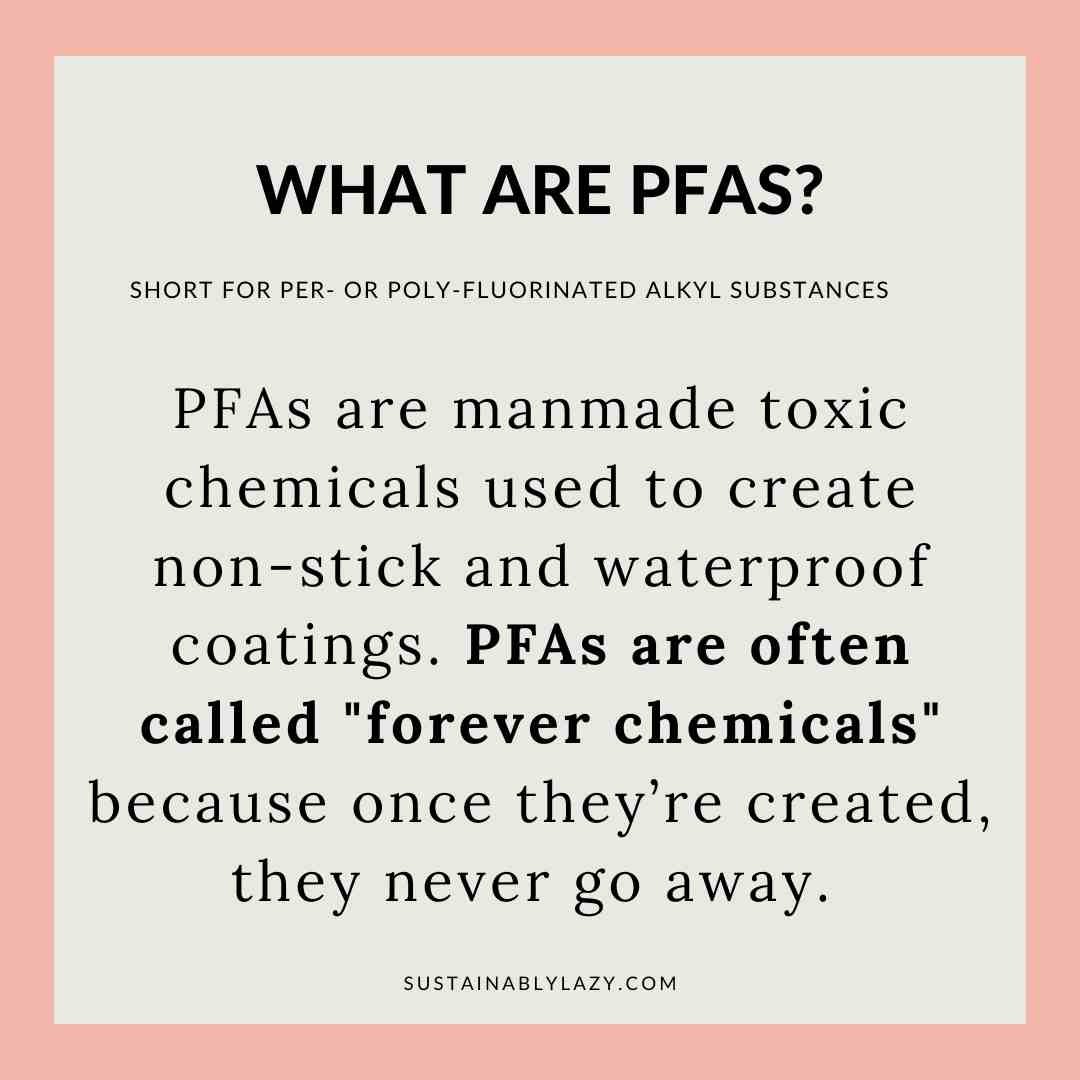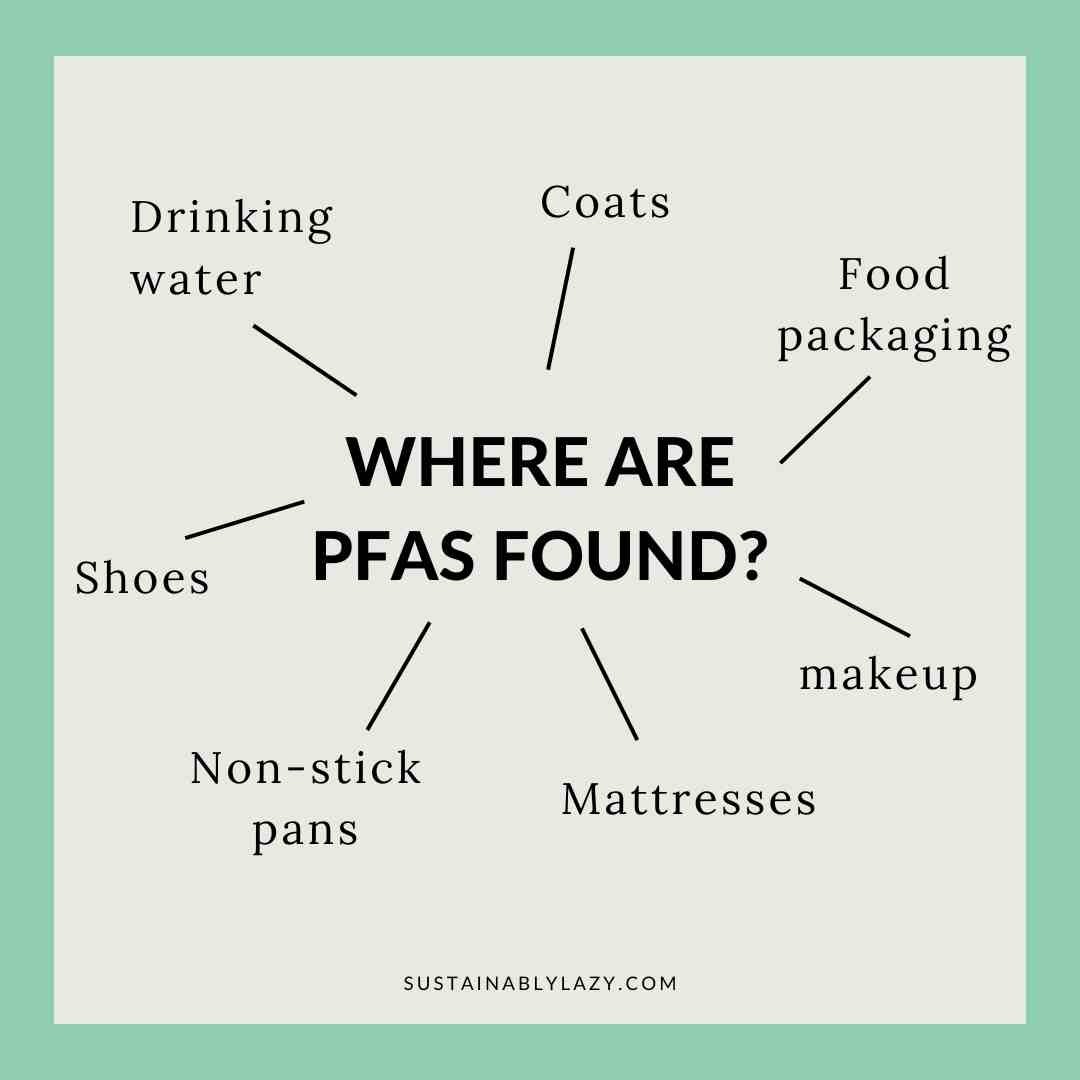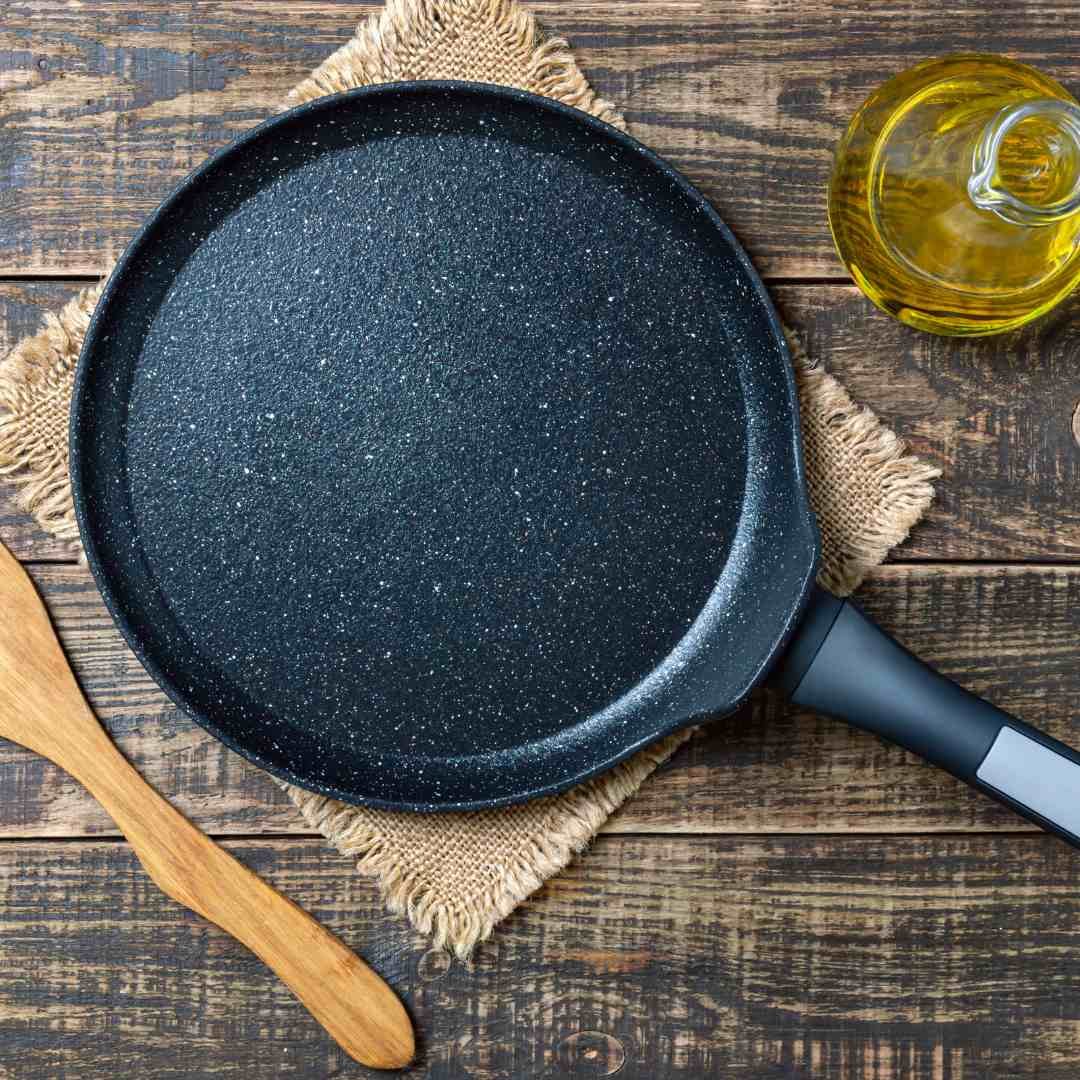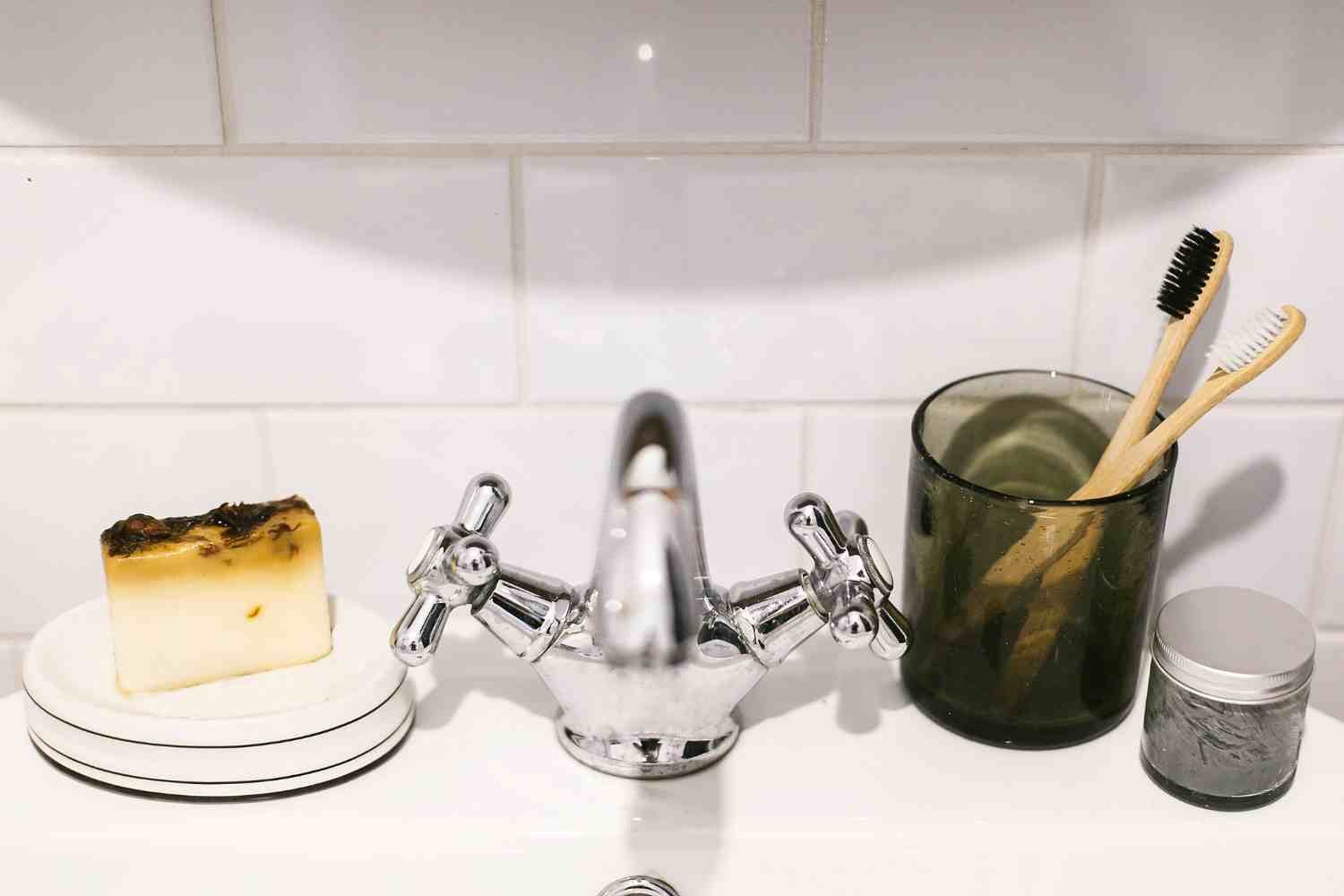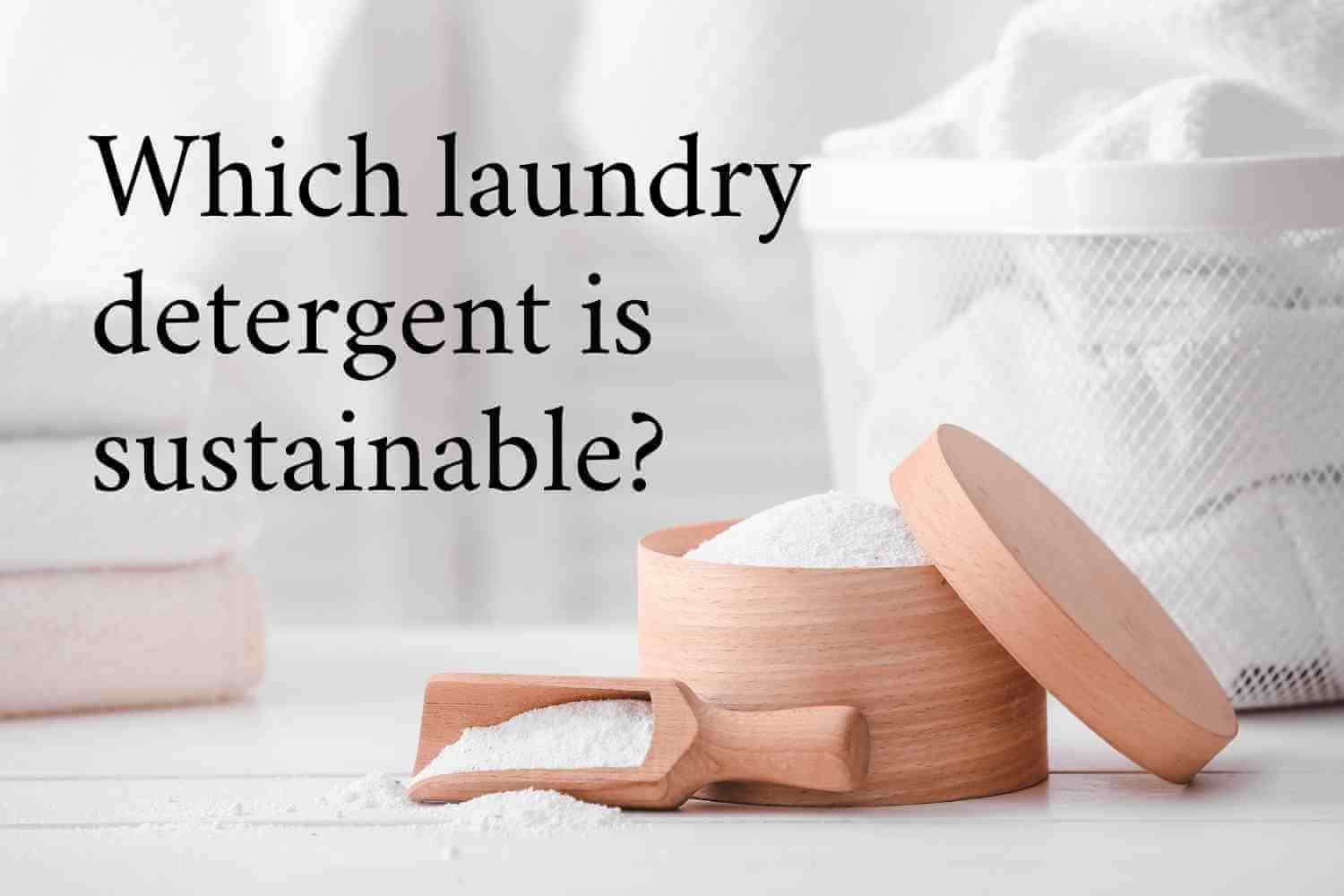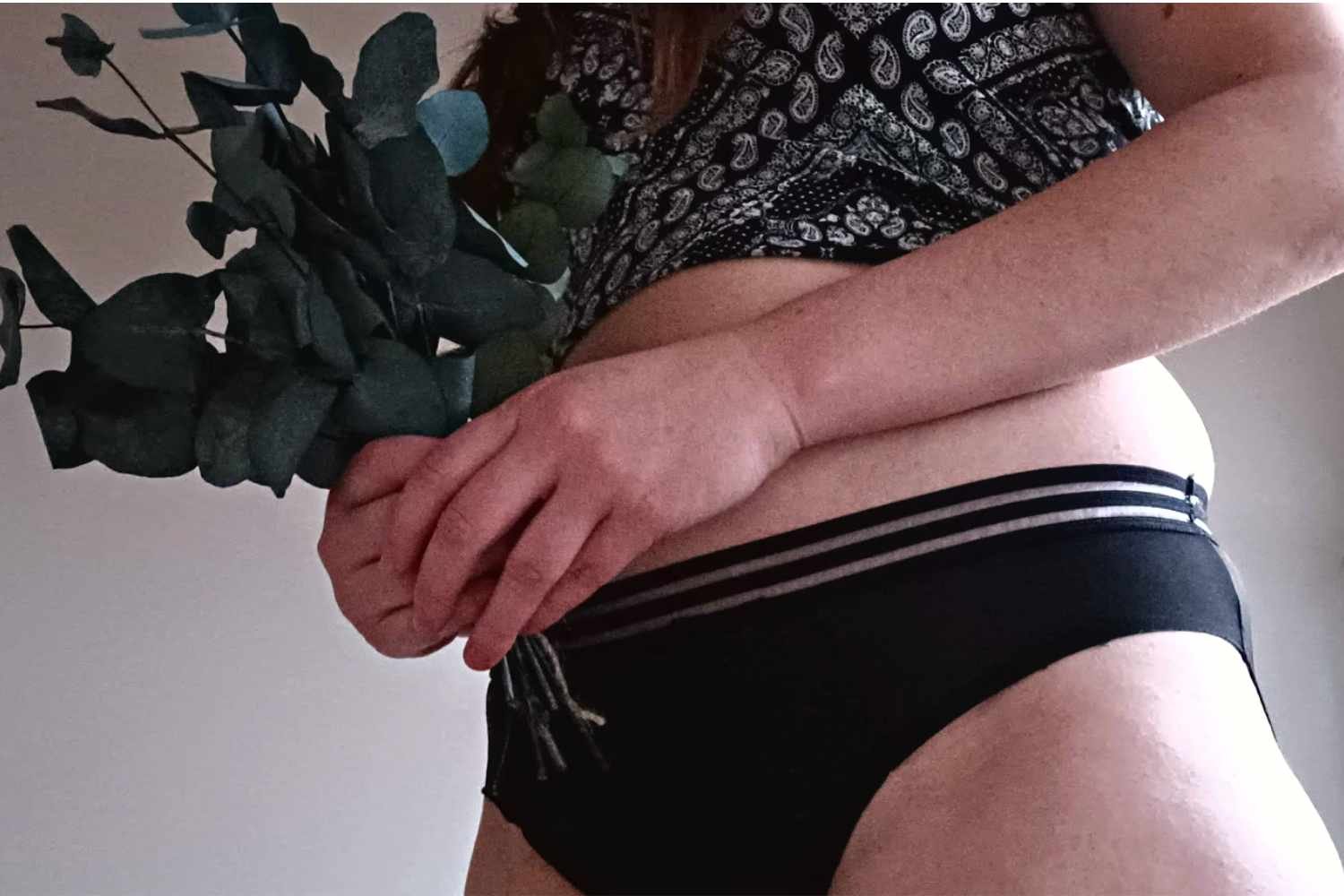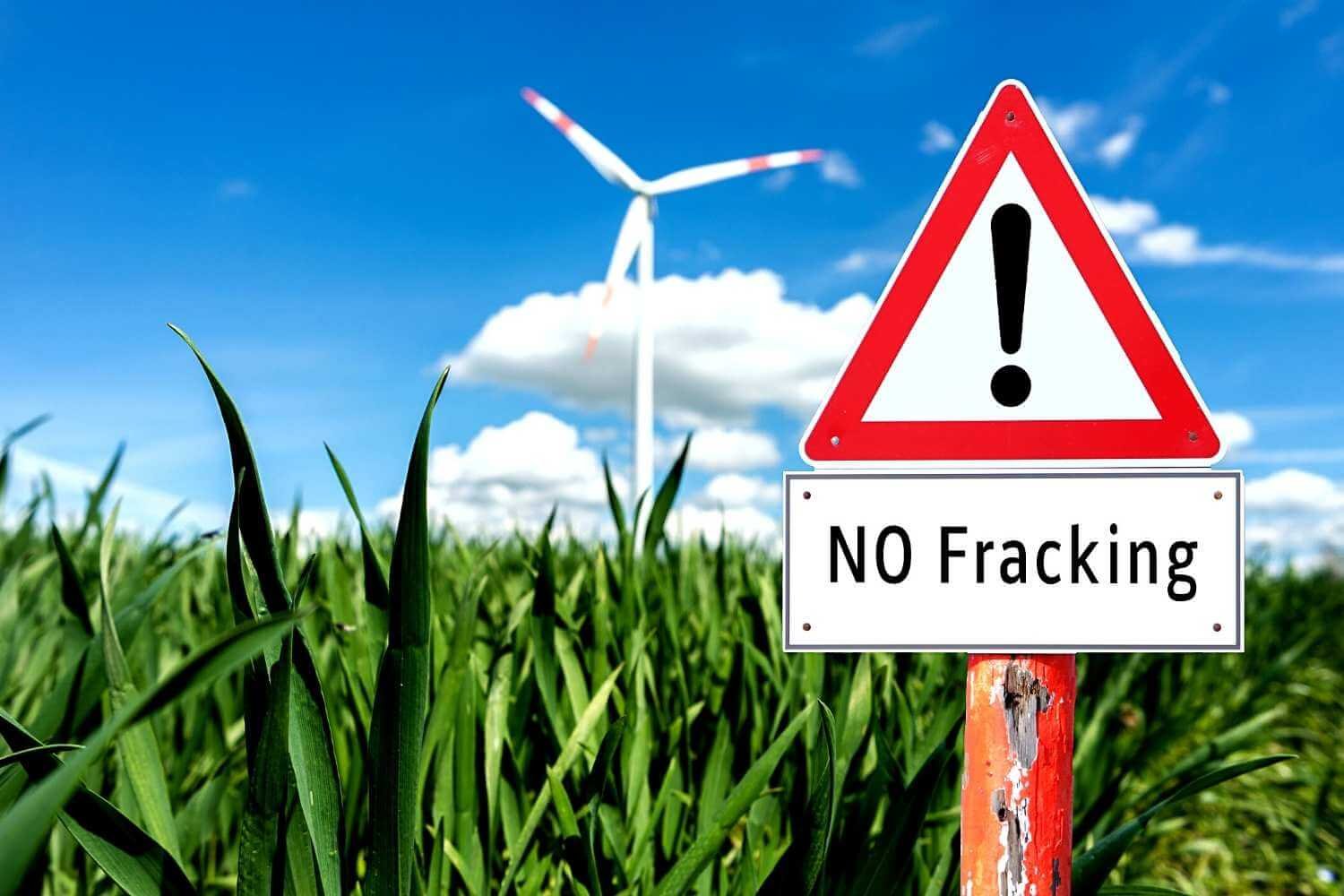10 Top Tips For Reducing PFAS Chemicals From Your Home
Want to banish those pesky PFAS from your home? Keep reading for ten ways to reduce ‘forever chemicals’ alongside PFA-free product recommendations.
This site is reader supported and uses affiliate links
I’ll start with the bad news; PFAS are in your house right now.
Also known as “forever chemicals,” PFAS are toxic substances added to products to make them resistant to water, oil, and heat.
This means they are finding their way into your body through everyday items, like waterproof mascara and frying pans.
The good news is I have ten tips to help you start reducing “forever chemicals” at home. Keep reading if you want recommendations for PFAS-free products so you can banish them once and for all.
What are PFAs?
Short for per- or poly-fluorinated alkyl substances, PFAs are manmade toxic chemicals used to create non-stick and waterproof coatings. PFAs are often called forever chemicals because once they’re created, they never go away.
The different types of PFAs
When avoiding PFAs, you will come across different abbreviations, such as PFOA. There are a number of different types of PFAs, some of which are banned in specific places.
There are over 4,700 types of PFAs but the most commonly studied are:
Perfluorooctanoic acid (PFOA) - is used in non-stick pans and appliances
Perfluorooctane sulfonic acid (PFOS) - makes textiles and clothing waterproof
As these are the two most known and regulated PFAS, many products will be labelled PFOA-free. This is misleading because it does not mean that the product is free from all PFAS, just the common ones.
Where are PFAS found?
You are exposed to PFAs in multiple ways. They have been found in food packaging, bags, drinking water, seafood, and even dust.
It is impossible to avoid PFAs completely, but you can limit your exposure by choosing products manufactured without PFAs and contacting companies to make them aware of the issue.
PFAS are often found in:
In textiles (e.g. period products, waterproof outdoor clothing, mattresses)
In paper and cardboard food packaging (e.g. pizza boxes, ready-made cakes)
In appliances (e.g air fryers)
In non-stick cookware
In cosmetics (e.g. makeup, hair conditioner, sunscreen etc.)
In electronics (e.g. televisions, computers, smartphones)
Drinking water is the main way people are exposed to PFAS
The UK currently only regulates 2 of the 4700 PFAs on the market (PFOA and PFOS)
In 2021, the Environment Agency found PFAS in 96% of English rivers
A study conducted by The Waterkeeper Alliance found PFAS in 83% of US waterways in 34 states, many of which exceeded allowed limits.
What do PFAs do to your body?
If you’re worried about the health impacts of PFAS, you are not alone.
Studies have shown links between exposure to PFAs and a wide range of health concerns, such as behavioural issues in children, miscarriage, and cancer.
They also impact the body’s immune system and have been linked to a reduced response to vaccines
Europe has officially classed PFAs as harmful to human reproduction (“reprotoxic”), toxic to the liver, carcinogenic (meaning they have the potential to cause cancer) and may cause harm to breastfed children.
PFAs are in the blood. A national sample in 2015 found PFAS in the blood of almost all Americans, but they have been detected in the blood and breastmilk of people and wildlife globally.
A study linked PFAS to the following diseases:
testicular cancer
kidney cancer
ulcerative colitis;
thyroid disease;
high cholesterol;
pregnancy-induced hypertension.
10 Top Tips for removing PFAS from your home
The following 10 tips will help you reduce and avoid PFAS in your homes by allowing you to shop consciously.
It is highly likely you have products that already contain forever chemicals. It doesn’t make sense to throw everything away (unless you’re concerned about the toxicity of a product) as it wastes the Earth’s resources.
Instead, donate or sell the products to people who would be buying them new anyway to reduce your environmental impact and only buy new products when it’s time to replace them.
1. GET A WATER FILTER THAT REMOVES PFAS
Although we are exposed to PFAS in a variety of ways, the biggest source is our drinking water. Thankfully there are water filtration systems you can buy to filter out these toxic chemicals.
In 2020, a study looked at 89 water filters in people’s homes and assessed their abilities to remove PFAS. It was discovered that reverse osmosis systems were the most effective at removing Poly and Perfluoroalkyl Substances.
What is a reverse osmosis system? It is a water purification process that forces water through a semi-permeable membrane at high pressure. This filter out large particles and unwanted molecules, like contaminants and pollutants.
DO BRITA FILTERS REMOVE PFAS?
No, Brita filters do not filter out PFAS, however, a new cartridge called Purefast has recently been developed to remove PFAS. Right now, this filter only seems to be sold in the USA.
2. DUST AND HOOVER MORE OFTEN
PFAS stick to dust particles so the more dust you have in your home, the more likely there are ‘forever chemicals’ in the air you breathe.
The solution is to wipe down dust with a damp cloth, mop hard floors, and vacuum the carpets.
It is not essential, but if you need to replace your vacuum cleaner, look for one with a HEPA filter which traps all the dust inside instead of releasing it back into the air as some vacuums do.
(Shark vacuums have HEPA filters.)
Vacuuming regularly is a great way to reduce the PFAS (and other toxic chemicals) in your home.
3. SWAP TO NON-toxic COOKWARE
You may want scratch-resistant and non-stick pans for convenience, but using them comes with chemical exposure from PFAS, BPA, and heavy metals over time.
Most non-stick cooking pans are coated with a polymer form of several PFAS called polytetrafluoroethylene (PTFE), also known as Teflon.
Teflon pollutes the air, water, and soil during manufacturing, often in Asian countries where labour rights are worse. Next, the PFAS get washed down the drain every time we clean them and end up in wildlife all over the world.
Brands can be misleading when describing the coating on their cookware. Sometimes they say “PFOA-free” while hiding the fact the pan contains different PFAS.
When buying new cookware, consider both the base material too. Some people prefer to avoid aluminium due to it being potentially harmful to your health at high levels.
It’s also worth avoiding other small kitchen appliances, like air fryers or toaster ovens, that usually have non-stick coatings that will leach forever chemicals into your food.
SAFER COOKWARE:
UK:
Greenpan stainless steel - (non-stick**)
Our Place - ceramic (Non-Stick*)
Habitat - Cast iron pan
IKEA Vardagen - Carbon Steel
Pyrex baking trays
Pyrex roasting/ Oven dish
USA:
The Field Company - Cast iron skillets
Xtrema - 100% Pure ceramic
DeBuyer - carbon steel pans
Greenpan - Stainless Steel (Non-stick**)
Our Place - ceramic (non-stick**)
Lodge - cast iron skillets
Stargazer - Cast Iron
**If you really need a non-stick coating, Green Pan and Our Place appear to be the safest choices due to having a PFAS-free coating. The exact formulas, which are silicone-based, are proprietary, however, they have passed testing. Some Greenpan cookware is made from aluminium so make sure you read product descriptions carefully if you’re avoiding that.
4. Bake without PFAS
When baking, many foods rely on the equipment being non-stick. This is problematic when the non-stick coating contains PFAS. The following bakeware is free from PFAS.
SAFER BAKING PRODUCTS:
UK:
If you care - cupcake cases
If you care - parchment paper
Pyrex mixing bowl
Stainless steel muffin tin
USA:
If you care - parchment paper
Xtrema pure ceramic muffin pans
Debuyer steel cake + bread loaf molds
Greenlife Muffin pans (PFAS-free nonstick coating)
5. non-toxic MATTRESSES
“Research using artificial saliva and sweat indicates that persistent PFAS, especially the newer, more water-soluble compounds, can move directly from products to the user”
PFAS are used in mattresses (including cribs) for their waterproofing qualities. Look for mattresses that are free-from foam, and don’t have stain-resistant properties.
To keep your mattress in good condition, invest in decent mattress protectors instead.
PFA-FREE MATTRESSES:
Little Green Sheep (UK)
Naturepedic (USA)
Avocado (USA)
Review: The Little Green Sheep baby and toddler mattress review
Image: Bumbleride indie twin stroller
6. BABY TRAVEL SYSTEMS
Car seats were first tested for per and poly-fluorinated alkyl substances in America in 2018. The PFAS are added to materials to make them repellant to water and stains.
As PFAS can migrate through saliva, it is concerning that most car seats and strollers are allowed to contain toxic “forever chemicals” without disclosing them.
There are a few options for chemical-free car seats on the market, but they tend to be significantly more expensive which means children from lower-income families are more likely to be exposed to PFAS and flame retardants.
The majority of car seats in the UK and USA are also filled with flame retardants due to outdated regulations. Many of these chemicals are associated with cancer, abnormal brain development, and hormone disruption.
Even though there are worse flame retardants in the USA, there are very few children’s travel systems in the UK that don’t contain toxic fireproofing chemicals.
If you’re on a budget, you may be better off buying a secondhand stroller which will have had more time for the toxic chemicals to off-gas.
In the USA, you can buy secondhand strollers from Good Buy Gear
Further Reading: 2022 Car Seat Report
PFA-FREE CAR SEATS (WITH NO FLAME RETARDANTS):
UppaBaby car seat (UK) - wool and polyester mix
UppaBaby car seats (USA) - wool and polyester mix
Nuna Pippa Infant - polyester (USA)
Nuna Pipa Lite LX - merino wool + tencel (USA)
*Britax (Safewash range only) (USA)
*ANB Baby has given me a 5% off code to share with my readers: LAZY5 - they sell a range of car seats and strollers
Maxi Cosi PureCosi Mico 30 Infant
Maxi Cosi Pria Max All-in-One
(For information about buying non-toxic Maxi Cosi car seats if you live in the UK, check out this Mumsnet thread!)
PFAS-FREE STROLLERS
All Bumbleride strollers (USA)
Bumbleride Pushchairs (UK)
Nuna Next Strollers (USA)
7. SWITCH TO PFA-FREE COSMETICS
When it’s time to replace your makeup and personal care products,
Scientists tested more than 200 makeup products and found:
82% of waterproof mascara had high levels of PFAS
47% of all mascaras had high levels of PFAS
63% of foundations had high levels of PFAS
62% of all lip products had high levels of PFAS
In the UK, the BBC reported three brands, Urban Decay (Loreal), Revolution, and Ingrid were still using forever chemicals.
SAFER BEAUTY BRANDS:
US:
UK:
I have been emailing ethical UK brands about testing for PFAS and will update this list once I have results.
100% Pure - ships from uSA (see FAQ)
Lily Lolo - natural mascara
H&M - lipstick + mascara (synthetic)
HOW DO PFAS GET INTO COSMETICS?
Some brands add PFAS intentionally, so you can try and avoid any items with “fluoro” or “perfluoro” on the ingredient list.
The bigger challenge is that manufacturing equipment used in factories has been coated with Teflon (PTFE), which then leaches into the products.
The only true way to know if factory-produced makeup is PFAS-free is if it has been tested, but as PFAS are mostly legal at the moment, companies aren’t doing this.
HOW TO FIND COSMETICS WITH NO PFAS?
Unfortunately, there isn’t any way of working out which brands are 100% free from PFAS unless a huge test is done, or brands start testing their own products and sharing the results.
The best thing to do is:
avoid any makeup or sunscreen that’s waterproof or extremely long-lasting
check ingredients lists for the letters “fluoro.” (Here is a list of PFAS ingredients to avoid in makeup)
choose organic, handmade products over brands that mass-produce overseas to reduce the risk of Teflon-coated factory equipment.
100% PURE
Since it began, the American beauty brand, 100% Pure, has been avoiding PFAS from the start.
When 231 makeup items were tested, 100% Pure were one of a handful of brands that had no detectable levels of PFAS (there were a few others, however, they were MLMs. Sustainably Lazy is against multilevel marketing due to the unfair recruitment-based business model exploiting women and does not recommend these brands).
Even though it passed 100% Pure has been retesting its products to ensure they are of the highest quality.
All products are cruelty-free and made from naturally-derived ingredients.
Browse 100% Pure
8. MAKE HOMEMADE TAKEAWAYS
In our fast-paced modern society, I know it’s impossible to give up takeaways for most people.
If you have the time, one thing you can do to make it easier for yourself is to try and make your favourite fast food at home, batch cook it and pop it in the freezer for those days it’s too much effort to cook.
I always find I have more success *adding* healthy habits over giving things up. So rather than trying to quit takeaways, I try to add more homecooked food.
Having a plastic-free diet is pretty much impossible, so take it one step at a time to prevent getting overwhelmed.
Slow cookers are also a great way of batch-cooking food when you have a busy lifestyle.
9. CHOOSE NON-TOXIC OUTERWEAR
If you want to avoid PFAS, you should avoid buying clothing with labels indicating it is water or stain-repellant. Obviously, you want to stay dry in the rain, so choose outerwear brands that use PFAS-free coating.
If a product says “PFOA-free,” that means it has only banned the worst PFAS and it likely contains short-chain PFAS still. Unfortunately, increasing research on these is showing they may be just as harmful. You must look for “PFAS-free” to ensure all variations of the chemicals are covered.
Because brands, like Patagonia, have said the non-toxic alternatives aren’t as effective, the certifier OEKO-TEX will approve a certain amount of short-chain PFAS in the manufacturing and finishing of some water-resistant outdoor products. This is problematic, however, many outerwear brands have been making PFAS clothing for years so there is plenty to choose from in Europe and the USA.
COATS + OUTERWEAR WITHOUT PFAS
UK/EU:
Polarn O pyret (view policy) - kids
Houdini Sportswear (EU)
Adidas (sustainable collection)
H&M - banned PFAS from its clothing in 2013
Endura Sport
M&S Clothing
USA:
10. Shoes without PFAS
At this point, you’re probably not surprised that shoes also contain PFAS.
To make them waterproof, durable water repellency (DWR) treatments are used on all different parts of shoes to make the fabrics suitable for wet weather. DWR treatments contain perfluorinated chemicals (PFCs).
The following shoe manufacturers are PFAS-free:
UK/EU
All Birds (UK) - eco-friendly
Keen - dispatches from EU
Adidas Sustainable Collection
USA
If you found this post useful, help spread the word by tapping this Pin and adding it to your non-toxic Pinterest board:
I will keep adding brands to this list as they are updated, so feel free to bookmark this page or sign up for my monthly green living mailing list.
If you found this useful please support my content by giving this a share on social media (via the red arrow at the bottom right). Alternatively, you can say thanks by buying me a coffee.


